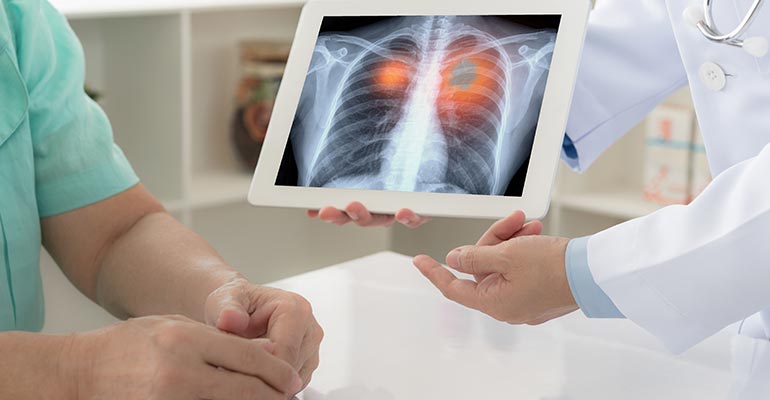

Lung cancer is the disease resulting from abnormal cell growth in lung tissue. Originating from epithelial cells, this usually malignant growth can lead to metastasis and infiltration of other tissues in the body. It is classified into two main groups:
- Small cell lung cancer (SCLC)
- Non-small cell lung cancer (NSCLC).[1]
Approximately 85% of all lung cancers diagnosed are non-small cell lung cancer (NSCLS) and 15% of all lung cancers are Small cell lung cancer (SCLC)and it is sometimes called oat cell cancer
Small cell lung cancer (SCLC)
15%
Non-small cell lung cancer (NSCLS)
85
1 American Cancer Society
This distinction conditions the treatment of each one.
Approximately 85% of all lung cancers diagnosed are non-small cell lung cancer (NSCLC). There are three main subtypes of NSCLC:
- Squamous cell carcinoma of the lung (25-30%).
- Adenocarcinoma (35-40%).
- Large cell lung carcinoma (10-15%).
Incidence
Lung cancer is one of the most important health problems worldwide. It is the leading cause of deaths from cancer (1.79M in 2020) and one of the most frequently diagnosed tumors. More than 2 million lung cancers are diagnosed every year. The incidence of lung cancer in Spain was 63.4 cases per 100,000 inhabitants (29,188 total cases) in 2020.
Lung cancer incidence continues to grow with an estimated 3.25 million new cases expected worldwide by 2035.
Wordwide, an estimated 2.21 million people were diagnosed width lung cancer 2020. Lung cancer incidence continues to grow with an estimated 3.25 million new cases expected worlwide by 20351
2020
2,2M
2035
3,2M
1 American Society of Clinical Oncology
Mortality
Due to the lack of adequate techniques for early detection, around 80% of cancer cases are currently diagnosed in advanced stages, precluding curative surgical resection.
Lung cancer survival at 5 years is, overall, 13-15% due to the aggressiveness of the disease and the lack of early detection, and it decreases to 4.3% in metastatic lung cancer. Reducing lung cancer mortality with early cancer diagnosis combined with primary prevention (such as smoking cessation) is therefore an urgent public health priority and the most effective strategy to do so.
Risk Factors:
- Smoking: Tobacco smoke is a deadly mixture of more than 7,000 chemicals, many of them toxic.
- Passive smoking: It has also increased the risk of developing lung cancer. In general terms, it is similar to smoking one or two cigarettes a day.
- Being in contact with toxic substances: Such as asbestos (insulation, mining, textile industry), petrol and petrol products, increases the rates of having lung and pleural cancer. It has also been correlated with exposure to nickel and radon.
- Genetic factors: The risk of developing lung cancer may increase when there is a family history of the disease.
- Pollution: Worldwide, it is estimated that around 500,000 lung cancer deaths can be attributed to air pollution.
Current diagnostic techniques:
The current techniques used to determine the presence of lung cancer are:
- Imaging tests: radiography, computerized tomography (CT), low-dose computerized tomography (LDCT).
- Sputum or bronchial lavage cytology. Tumours in the large bronchi of the lung, squamous cell tumours and large tumours may include cancer cells in the sputum or bronchial lavage.
- Tissue sample (biopsy). CT scans, guided bronchoscopy and ultrasound are often used to guide a biopsy.
- Endobronchial or transoesophageal endoscopic ultrasonography. Tumours affecting the mediastinum can often be diagnosed by endoscopy.
- May be the preferred option for those nodules considered to be high risk, but the procedure is invasive.
Low-dose computerized tomography is commonly used in screening studies; however, it has been criticised for its high rate of false positives, since a considerable number of the nodules detected are benign. In any case, most of these nodules identified in screening programs are small, a fact that significantly limits any invasive diagnostic intervention and makes it difficult to have a certain diagnosis. Likewise, surgery, although definitive, is very invasive.

In this sense, the combination of radiological findings with molecular markers could facilitate the identification of those patients with nodules detected by Low-Dose Computerized Tomography who have cancer and distinguish them from the large number of subjects with benign nodules.
Bibliography